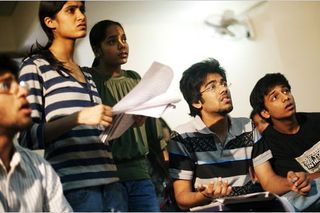
International Boards Aren’t Easier; They’re Just Better at Involving Kids in Learning
The decision to enroll a child in international versus Indian boards depends on their education goals.

The current Indian education system, with its plethora of boards and curricula available, can sometimes make it difficult to identify which school system is best for a child’s unique needs.
Parents often select boards based on certain preconceived notions about both Indian and international boards. While families may believe that one is easier than another, the truth is that each board is just different in its demands. These differences have given rise to certain myths.
In recent years, India has seen a tremendous growth of international boards. The International Baccalaureate Diploma Program (IBDP) courses, aimed at 16- to 18-year-olds, for example, were first offered in India by a single school in 1976; over the span of more than 40 years, IBDP schools in the country increased to now number more than 150. Similarly, the Cambridge International Examinations (CIE) program has been growing as well; admissions in CIE schools rose 10 percent each year between 2014 and 2016. This is in stark contrast to its domestic Indian counterpart, the Council for the Indian School Certificate Examinations, or CISCE board, which only saw 2 percent growth in admissions between 2013 and 2017.
Unsurprisingly, this influx of international schools has caught the attention of many parents, who see international board students taking fewer tuitions than their Indian board counterparts, and take that as a sign of an easier curriculum. But international boards such as the IBDP and the CIE just have smaller class sizes than most Indian board schools, allowing teachers to give students more individual attention and negating the need for additional tuitions.
Related on The Swaddle:
How Learning Differs Across India’s Education Boards
Students participation in extracurricular activities is also sometimes mistaken for an easier curriculum; some parents feel that since international board students engage in activities outside of school, they have more free time due to the curriculum being less challenging. This, again, is not true, as international boards are structured in a way that allow students to focus on activities outside of school, or include them in the curricula itself. For example, extracurriculars are a main component of the IBDP curriculum, even though they don’t contribute to a student’s final grade. Apart from this, the increasing number of students opting for international boards may be another factor influencing parents’ perceptions. In fact, these boards are actually challenging and may not be suited for all students.
On the other hand, schools following the Indian boards are focused on academics. The system is highly structured with prescribed textbooks and an emphasis on rote learning and grades. This, coupled with the larger class sizes with less individual attention, gives rise to some students enrolling in tuitions to cement what they have already learned in class. The need for extra classes makes parents believe that these curricula are more complex and difficult, which may not always be the case. In addition to this, since extracurriculars are not a formal part of Indian boards’ curricula, they often take a back seat to memorizing and recalling facts and details.
Are international boards easier?
No. Both Indian boards and international boards are challenging, though they differ in how they challenge students. The main difference is that the international curricula offer a more holistic education that focuses on interdisciplinary learning, reflection, analysis and evaluation, rather than on rote learning. For example, in an article in Forbes, the author talks to Dr Siva Kumari, director general of the International Baccalaureate, and states that the IB “place[s] a lot of weight on written critical analysis rather than bubble tests.” Bubble tests are multiple-choice questions, a testing method that is frequently used in Indian boards, where the correct answers can be guessed, with children not having to use any rationale behind it.
Apart from this, international curricula don’t require students to specialize early on. Students will have to study a range of subjects, regardless of their prowess or interest in the topics. Indian boards, however, provide a framework for students to choose, albeit broadly, what field or ‘stream’ they want to further study within. This enables students to gain knowledge in specific subjects only.
Related on The Swaddle:
How Teaching Differs Across Education Boards in India
It is very important to identify the learning style and goals of the student, and then choose the appropriate board accordingly. For instance, in the IBDP schools, students have to study a wide range of subjects that span multiple disciplines. This can be a big disadvantage for students who already know what they want to specialize in, like a student who is keen on medicine. The IBDP doesn’t allow students to take all three sciences, whereas Indian boards do. Similarly, engineering students who may want to attend the IIT institutions in India later on, may find the IBDP or an A-level curricula challenging. This is because the final grade 12 exams will overlap with the entrance exams for IITs, which coupled with the overload of work and holistic learning styles can result in students struggling during their last two years. Eventually, they may not get a competitive result, and may not be admitted into a top IIT school or even a top global institution. For a student with a goal like this, taking the Indian board is the right choice.
While both international and Indian curricula have universal content and subjects, their approach is extremely different. For example, in an Indian CISCE history examination, the student may be asked a question that will require them to list down all the events that occurred in World War I. On the other hand, the IBDP, CIE or even an A-level curricula may ask a more open-ended question, something along the lines of, “To what extent is World War I justifiable?” To answer either one of these questions, students will need to know the same content. The difference is that since the latter question requires additional inquiry and an innate understanding of the relationship between various subjects, it is perceived as easier since no facts and dates need to be memorized. In fact, going beyond the facts is just as challenging or sometimes even more so, as the student has to present their point of view in a cohesive manner.
Before deciding which board to go ahead with, families must understand the differences and consider their students’ future goals. There isn’t one specific board that comes out on top of the others. Find the board that fits your child’s future goals and learning preferences and then decide which board your child should study in.
Nainika Ajani is the manager for early advising at The Red Pen, where she guides high school students in building their profiles. She holds a BSc from CASS Business School at City University London.
Related


Priya Alika Elias’s ‘Besharam’ Dismantles the Trope of the Good Indian Girl
